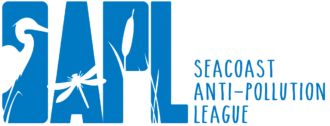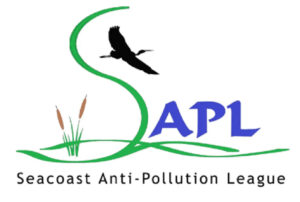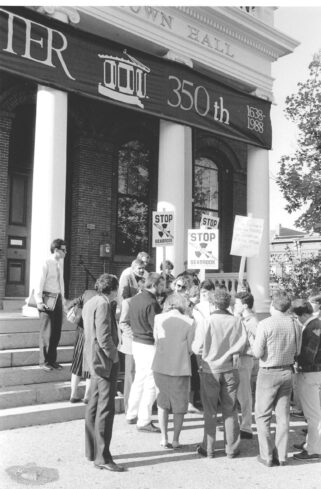The Seacoast Anti-Pollution League (SAPL) was formed in 1969 in response to the Public Service Company of New Hampshire’s announcement of intent to construct a nuclear power plant in Seabrook, New Hampshire. Although formed in response to the proposed plant, SAPL formulated its mission to encompass other seacoast New Hampshire environmental concerns. Even so, SAPL’s primary emphasis from inception through the 1990s was on the Seabrook plant.
From the time that Public Service of New Hampshire (PSNH) began to survey the proposed Seabrook location and seek initial approval from state and federal governments, SAPL engaged in legal intervention to halt and/or hinder the process. Through these actions, SAPL challenged the issuance of construction permits, preventing shortcuts and forcing PSNH to consider some of the many environmental impacts of the plant. SAPL forced design changes on the plant’s cooling tunnels to ensure that their intake/outfall was offshore and away from the estuary and sought various other changes in design to preserve the salt marshes upon which the plant was built.
As construction continued in the early 1980s, SAPL’s emphasis shifted to concern about emergency preparedness and nuclear safety issues. The organization played a major role in several hearings before the US Nuclear Regulatory Commission (NRC) regarding issuance of an operating license to PSNH. Together with the Attorney General’s Office of Massachusetts and the New England Coalition on Nuclear Pollution, SAPL sought to prevent the issuance of an operating license on the grounds that both the company’s and state’s radiological emergency plans were inadequate for the assurance of public safety due to very large beach populations, unique weather and storm events, limited roadway egress, and other conditions.
PHOTO (1988) SAPL prepares to travel to Washington to deliver a 35,000-signature petition to Congress and the Nuclear Regulatory Committee. This petition prevented the Emergency Planning Zone from being shrunk from our current (and extremely inadequate) 10 mile radius to a one mile radius. In addition to being reckless, this would have prevented towns in Massachusetts (which are within the 10 mile radius) from having any say at the regulatory hearings regarding Seabrook’s Emergency Planning issues.
While ultimately unable to end plant construction, SAPL and other groups were successful in forcing the abandonment of a clearly uneconomic and unneeded second reactor at Seabrook. Since the plant opening, SAPL has continued to operate in a watchdog role, forcing the plant to prevent harbor seal deaths through water intake pipe, getting state officials to begin distributing potassium iodide (KI) radiation protection, and drawing public attention to waste shipment issues, emergency generator problems, and security lapses at the plant. We have also pressed state officials to consider real-time monitoring of radiation releases, as is done south of the state border, and released a report on increases in child cancer rates in the Seacoast region.
With the designation of the Portsmouth Naval Shipyard as a federal superfund toxic site in 1995, SAPL sought and obtained an U.S. EPA Technical Assistance Grant (TAG) to hire a consultant to oversee the ongoing cleanup process. A key result of SAPL’s efforts at the Shipyard was the Navy’s restoration of Jamaica Cove into a functioning salt marsh and mudflat, undertaken as part of the consolidation of the 25-acre Jamaica Island landfill and justified as a natural buffer to any further toxic contamination of Portsmouth Harbor.
In 2010, Seabrook plant owners submitted an application to the NRC for a 20-year license renewal, thereby extending the plant to the year 2050 despite the fact that their current license doesn’t expire until 2030. In response, SAPL joined a group of local, regional, and national groups intervening to oppose this premature action. Our intervention contention was that the plant owners’s application and environmental impact statement failed to give proper consideration to renewable power alternatives (principally offshore wind) to Seabrook—as required by federal environmental law under the National Environmental Policy Act (NEPA).
Despite being granted intervenor status by their Atomic Safety Licensing Board, the NRC eventually denied SAPL’s status and threw out our contention altogether (meaning there would be no public hearing over the license renewal), leaving us no other viable option but to sue them in federal appeals court. We argued that the NRC short-circuited the process by preemptively rejecting our contention on renewable alternatives before we even had a chance to present them before the NRC licensing board.
By denying our appeal in early 2013, the court gave the NRC wide discretion in determining the terms of the debate – including when and where an alternative should be in evidence – despite the fact that the plant is projecting its own viability several decades into the future without empirical evidence (and with so many factors arguing against its future viability). Subsequent joint petitions and appeals by regional and national groups (all joined by SAPL) over spent fuel management and regulatory changes informed by the Fukushima disaster were also denied by the NRC or federal courts.
Despite these legal setbacks, SAPL and others continued to challenge the the license renewal process, primarily over concerns in plant construction – specifically the gradual degradation of the plant’s concrete foundations from chronic exposure to water (known as the Alkali-Silica Reaction). In 2012, SAPL and other organizations raised concerns at a public meeting on the ongoing analysis of Alkali-Silica Reaction (ASR) at Seabrook. ASR is a common problem in aging concrete structures, but Seabrook is the only US nuclear plant known to have the condition. Despite these concerns and another legal intervention by our ally C-10, the NRC issued a 20-year license renewal in 2019 before the required public hearing was even held, claiming that ASR degradation wouldn’t affect the safety and continued operation of the plant. After holding the hearing later that year, the Atomic Safety Licensing Board ruled that ASR was indeed a concern and that plant owner NextEra needed to do more to monitor the problem in coming years.
In recent years, SAPL has sponsored a series of community forums on energy options and renewable energy development, particularly offshore wind, national nuclear issues, and energy policy. Recent forums have focused on the Seabrook re-licensing battle, the emerging problem of ASR degradation of Seabrook’s foundations, the offshore wind power potential for our region, and lessons to be learned from the ongoing Fukushima nuclear disaster in Japan.
In 2019, SAPL celebrated its 50th anniversary, with a lively gathering featuring longtime SAPL attorney Bob Backus and former NRC Chair Gregory Jaczko. Since leaving the NRC in 2012, Jaczko has become a strong critic of US nuclear power policy, authoring “Confessions of a Rogue Nuclear Regulator.” Our anniversary event celebrated our successes and highlighted issues still to be addressed to ensure a safe and sustainable environment for current and future Seacoast residents.
PUBLIC ARCHIVE: The Seacoast Anti-Pollution League Papers, 1969-1989
The Seacoast Anti-Pollution League Papers are a thoroughly documented history of SAPL and the building of the Seabrook power plant. This 74 box collection is housed and maintained by the Milne Special Collections and Archives at the University of New Hampshire Library in Durham, New Hampshire.
About the Collection
The Seacoast Anti-Pollution League Collection contains five series, primarily covering the years 1978 through 1989. The first series contains materials about the creation, function, and organization of SAPL. The second series contains reports analyzing safety and environmental concerns surrounding the construction and operation of the Seabrook Nuclear Power Plant, while the third series consists of materials relating to the issuance of a license for the construction of the plant.
The fourth series comprises materials related to the fight over the issuance of an operating license. SAPL took an active role in seeking the denial of this license because of its concerns with emergency preparedness issues and nuclear safety. The papers in this series reflect SAPL’s emphasis on participation in the relevant hearings before the various boards of the Nuclear Regulatory Committee. The final series contains miscellaneous documents concerning the Seabrook Nuclear Power Plant from sources other than SAPL.


